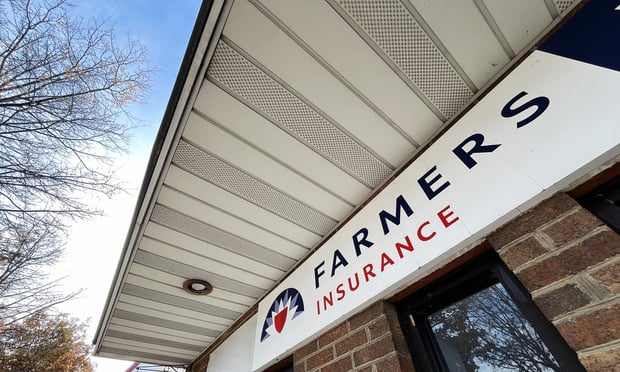On Aug. 24, 1992, with winds whipping at more than 165 miles per hour, Hurricane Andrew made landfall at Homestead, Fla. and tore through the Sunshine State. Some say the damage had to be seen to be understood. At least that's what the sister of Tom Gallagher told him.
Gallagher, then the Florida insurance commissioner (as well as the state's treasure and fire marshal) had made some boilerplate remarks to the media following the storm about getting adjusters out to the scene and paying claims. His sister thought his statements were insensitive—that they lacked a grasp of what people had just been through.
“She said, 'Don't you have any compassion at all?'” Gallagher says, remembering a phone call from his sister.
“You need to see this place,” she told him. He took her advice and got in a helicopter to go to some of the spots with the worst damage. Homestead, he says, was destroyed.
“There was nothing higher than your knees—everything was leveled,” Gallagher says of a mobile home park he toured. “Everything was grey and black. There was no green. The palm trees had no palms.”
Gallagher's up-close-and-personal inspection hammered home just how devastating the damage was, and he required many insurance company executives take helicopter rides with him in the days following Andrew in order to visit insureds.
“I wanted them to see the faces of the people they insured—the folks who had paid them money in case something like this happened—the folks who were just trying to get back on their feet,” Gallagher says.
It worked to a point. By February 1993 a report by Gallagher indicated insurers had already paid out more than $11 billion to policyholders despite there being no real standard to handle the unprecedented situation Andrew offered.
Mass Exodus
A month after Andrew left, a special session of the state legislature was called to basically shake out the cobwebs and figure out a plan. By that time, Allstate already told Gallagher they had plans to not renew more than 800,000 policies, he says. Other carriers were coming up with similar plans to non-renew, cancel, and reduce the number of new policies written.
“Companies hadn't been tracking exposures on a detailed basis,” says Karen Clark, the mother of catastrophe modeling and the founder of what is now catastrophe modeler AIR Worldwide.
Making matters worse, no one was lining up to take the policies being left behind by the fleeing national carriers, who wrote 94 percent of the homeowners' business. (Today, national carriers make up less than 20 percent of the market.)
“Right away we had a true [availability and affordability] emergency on our hands,” says Gallagher, who is now with the law firm Colodny, Fass, Talenfeld, Karlinsky & Abate as a consultant in its governmental consulting and insurance-regulatory practice.
Proof the storm caught many carriers by complete surprise, Andrew caused the insolvencies of eight insurance companies and the “technical insolvencies” of others—subsidiaries that required funds from a parent company to pay claims, according to a report by Lynne McChristian, Florida representative of the Insurance Information Institute.
“I remember speaking to one company executive, and he said he thought his agents were doing a bang-up job,” relays Gary Kerney, assistant vice president of Verisk's Property Claim Services. “The [premiums] were pouring in. Then all of a sudden they were paying out more money than they had made the previous 20 years.”
Birth and Evolution of Models
Andrew catapulted Karen Clark & Co.'s catastrophe model product, which issued a staggering insured-loss estimate of $13 billion for Andrew soon after the storm. The industry had predicted a far less expensive worst-case scenario for Florida based off losses sustained from 1989's Hurricane Hugo in South Carolina, which caused about $4 billion in insured losses.
“The industry tended to look at what just happened versus what could happen,” Clark says.
Before the hurricane, the data reinsurers had asked from clients was limited to state premiums by line of business. Immediately following Andrew, however, reinsurers wanted more exposure data; and insurers—who had been focused more on market share rather than underwriting—realized quickly that they were significantly concentrated on the coast.
“It wasn't a consideration before,” says Kerney of coastal exposure management. “Even when Karen's estimate came out, it wasn't taken seriously. [Insurers] thought it was impossible.”
Andrew “revealed that Florida's vulnerability to hurricanes had been seriously underestimated,” says McChristian.
Therefore, there was a massive reassessment of coastal risk. Using the services of a new catastrophe-modeling industry, insurers looked to get a more accurate read on exposure concentrations and were to turn to the reinsurance industry for a better spread of risk.
“Carriers started tracking exposure, getting a better understanding of the values,” Clark says. “Gone are the days when insurers would pin locations of exposures on a map and use an arbitrary percentage of total insured value to come up with a probable maximum loss, remembers AIR Worldwide, which adds that insurers have “made great strides toward improving the quality and resolution of their exposure data.”
Catastrophe models “took off” after Andrew, says Rich Attanasio, vice president of P&C ratings at A.M. Best Co., as companies were “forced to understand their exposure.”
“Insurers developed a whole new risk-management framework, and we look for companies to take ownership of that—to truly understand exposure and not be solely reliant on catastrophe models,” he adds.
Reluctant Solutions
Models became an instant beneficial tool for insurers, but that didn't help Florida's immediate property insurance crisis. Gallagher issued numerous emergency rules related to the quick reduction in insurers' appetite to write in Florida. He had to at least slow it down.For example, insurers had to submit plans to take any action in the marketplace 90 days before doing so—a rule that evolved in May 1993 to a 90-day moratorium on the cancellation and nonrenewal of policies. More regulations followed. Moratoriums were extended. Limits were placed on how much of an insurer's book it could not renew.
“They didn't necessarily like the rules imposed but they weren't going to challenge it under the circumstances,” Gallagher says.
He also allowed the Florida Property and Casualty Joint Underwriting Assoc., previously earmarked for last-resort commercial coverage, to provide residential coverage to homeowners with a non-insolvent insurer. Soon thereafter, legislators created the Residential PCJUA—the precursor to Citizens Property Insurance Corp.
At Gallagher's urging, state legislators authorized municipalities and counties to issue $500 million in tax-free bonds to fund a shortfall at the state guaranty fund. During a second special session prior to 1993's hurricane season, the Florida Hurricane Catastrophe Fund was established because the last-resort insurer had already expanded drastically, and its financial stability was questionable.
“There was a shortage of reinsurance,” Gallagher says. “It was impossible to get, let alone afford.”
The former insurance commissioner says he didn't really want to create a fund that would ultimately assess everyone in Florida if it needed to, and he would have preferred not to issue bonds that needed to be paid back by residents, but he says, “We were desperate.”
“No industry entrepreneurs [were] looking to invest in us,” he recalls. “I challenged everyone for better ideas. I certainly wasn't married to the ones we wound up going with. But we had to.”
Want to continue reading?
Become a Free PropertyCasualty360 Digital Reader
Your access to unlimited PropertyCasualty360 content isn’t changing.
Once you are an ALM digital member, you’ll receive:
- Breaking insurance news and analysis, on-site and via our newsletters and custom alerts
- Weekly Insurance Speak podcast featuring exclusive interviews with industry leaders
- Educational webcasts, white papers, and ebooks from industry thought leaders
- Critical converage of the employee benefits and financial advisory markets on our other ALM sites, BenefitsPRO and ThinkAdvisor
Already have an account? Sign In Now
© 2024 ALM Global, LLC, All Rights Reserved. Request academic re-use from www.copyright.com. All other uses, submit a request to [email protected]. For more information visit Asset & Logo Licensing.








